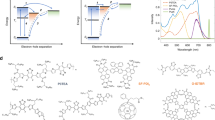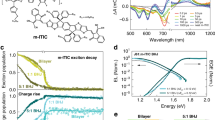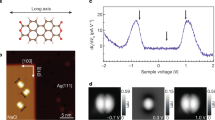Abstract
Charge-transfer (CT) states, bound combinations of an electron and a hole on separate molecules, play a crucial role in organic optoelectronic devices. We report direct nanoscale imaging of the transport of long-lived CT states in molecular organic donor–acceptor blends, which demonstrates that the bound electron–hole pairs that form the CT states move geminately over distances of 5–10 nm, driven by energetic disorder and diffusion to lower energy sites. Magnetic field dependence reveals a fluctuating exchange splitting, indicative of a variation in electron–hole spacing during diffusion. The results suggest that the electron–hole pair of the CT state undergoes a stretching transport mechanism analogous to an ‘inchworm’ motion, in contrast to conventional transport of Frenkel excitons. Given the short exciton lifetimes characteristic of bulk heterojunction organic solar cells, this work confirms the potential importance of CT state transport, suggesting that CT states are likely to diffuse farther than Frenkel excitons in many donor–acceptor blends.
This is a preview of subscription content, access via your institution
Access options
Subscribe to this journal
Receive 12 print issues and online access
$259.00 per year
only $21.58 per issue
Buy this article
- Purchase on Springer Link
- Instant access to full article PDF
Prices may be subject to local taxes which are calculated during checkout




Similar content being viewed by others
References
Segal, M. et al. Extrafluorescent electroluminescence in organic light-emitting devices. Nature Mater. 6, 374–378 (2007).
Zhu, X.-Y., Yang, Q. & Muntwiler, M. Charge-transfer excitons at organic semiconductor surfaces and interfaces. Acc. Chem. Res. 42, 1779–1787 (2009).
Deibel, C., Strobel, T. & Dyakonov, V. Role of the charge transfer state in organic donor–acceptor solar cells. Adv. Mater. 22, 4097–4111 (2010).
Gélinas, S., Poll, T. S. Van Der, Bazan, G. C. & Friend, R. H. Ultrafast long-range charge photovoltaic diodes. Science 343, 512–517 (2014).
Jailaubekov, A. E. et al. Hot charge-transfer excitons set the time limit for charge separation at donor/acceptor interfaces in organic photovoltaics. Nature Mater. 12, 66–73 (2013).
Lee, J. et al. Charge transfer state versus hot exciton dissociation in polymer-fullerene blended solar cells. J. Am. Chem. Soc. 132, 11878–11880 (2010).
Vandewal, K. et al. Efficient charge generation by relaxed charge-transfer states at organic interfaces. Nature Mater. 13, 63–68 (2014).
Yost, S. R. & Voorhis, T. Van. Electrostatic effects at organic semiconductor interfaces: A mechanism for ‘cold’ exciton breakup. J. Phys. Chem. C 117, 5617–5625 (2013).
Muntwiler, M., Yang, Q., Tisdale, W. A. & Zhu, X. Y. Coulomb barrier for charge separation at an organic semiconductor interface. Phys. Rev. Lett. 101, 196403 (2008).
Hallermann, M. et al. Correlation between charge transfer exciton recombination and photocurrent in polymer/fullerene solar cells. Appl. Phys. Lett. 97, 2008–2011 (2010).
Goushi, K., Yoshida, K., Sato, K. & Adachi, C. Organic light-emitting diodes employing efficient reverse intersystem crossing for triplet-to-singlet state conversion. Nature Photon. 6, 253–258 (2012).
Chang, W. et al. Spin-dependent charge transfer state design rules in organic photovoltaics. Nature Commun. 6, 6415 (2015).
Rao, A. et al. The role of spin in the kinetic control of recombination in organic photovoltaics. Nature 500, 435–439 (2013).
Loi, M. A. et al. Charge transfer excitons in bulk heterojunctions of a polyfluorene copolymer and a fullerene derivative. Adv. Funct. Mater. 17, 2111–2116 (2007).
Veldman, D. et al. Compositional and electric field dependence of the dissociation of charge transfer excitons in alternating polyfluorene copolymer/fullerene blends compositional and electric field dependence of the dissociation of charge transfer excitons in alternating. J. Am. Chem. Soc. 130, 7721–7735 (2008).
Akselrod, G. M. et al. Visualization of exciton transport in ordered and disordered molecular solids. Nature Commun. 5, 3646 (2014).
Pope, M. & Swenberg, C. E. Electronic Processes in Organic Crystals and Polymers (Oxford Univ. Press, 1999).
Uoyama, H., Goushi, K., Shizu, K., Nomura, H. & Adachi, C. Highly efficient organic light-emitting diodes from delayed fluorescence. Nature 492, 234–238 (2012).
Miller, A. & Abrahams, E. Impurity conduction at low concentrations. Phys. Rev. 120, 745–755 (1960).
Frankevich, E. L. et al. Polaron-pair generation in poly(phenylene vinylenes). Phys. Rev. B 46, 9320–9324 (1992).
Frankevich, E. L., Lymarev, A. A. & Sokolik, I. A. CT-excitons and magnetic field effect in polydiacetylene crystals. Chem. Phys. 162, 1–6 (1992).
Steiner, U. E. & Ulrich, T. Magnetic field effects in chemical kinetics and related phenomena. Chem. Rev. 89, 51–147 (1989).
Hu, B., Yan, L. & Shao, M. Magnetic field effects in organic semiconducting materials and devices. Adv. Mater. 21, 1500–1516 (2009).
Knapp, E.-W. & Schulten, K. Magnetic field effect on the hyperfine-induced electron spin motion in radicals undergoing diamagnetic-paramagnetic exchange. J. Chem. Phys. 71, 1878–1883 (1979).
Schulten, K. The effect of a magnetic field on the recombination of a radical pair. J. Mol. Liq. 86, 53–59 (2000).
Shushin, A. Magnetic field effects on electron–hole recombination in disordered organic semiconductors. Phys. Rev. B 84, 115212 (2011).
Braun, C. L. Electric field assisted dissociation of charge transfer states as a mechanism of photocarrier production. J. Chem. Phys. 80, 4157–4161 (1984).
Sweetnam, S. et al. Characterization of the polymer energy landscape in polymer: Fullerene bulk heterojunctions with pure and mixed phases. J. Am. Chem. Soc. 136, 14078–14088 (2014).
Vandewal, K. et al. Varying polymer crystallinity in nanofiber poly(3-alkylthiophene): PCBM solar cells: Influence on charge-transfer state energy and open-circuit voltage. Appl. Phys. Lett. 95, 93–96 (2009).
Congreve, D. N. et al. External quantum efficiency above 100% in a singlet-exciton-fission-based organic photovoltaic cell. Science 340, 334–337 (2013).
Acknowledgements
This work was supported by the US Department of Energy, Office of Basic Energy Sciences (Award No. DE-FG02-07ER46474).
Author information
Authors and Affiliations
Contributions
P.B.D., W.C. and P.D.R. made optical diffusion imaging measurements and analysis. W.C., D.N.C. and B.M. fabricated samples and made magnetic field effect measurements, including temperature and doping dependence. M.E.B. made transient electric field measurements. E.H., L.S. and C.K.L. provided valuable theoretical insights and performed Monte Carlo simulations. All authors discussed the results and commented on the manuscript.
Corresponding author
Ethics declarations
Competing interests
The authors declare no competing financial interests.
Supplementary information
Supplementary Information
Supplementary Information (PDF 2415 kb)
Rights and permissions
About this article
Cite this article
Deotare, P., Chang, W., Hontz, E. et al. Nanoscale transport of charge-transfer states in organic donor–acceptor blends. Nature Mater 14, 1130–1134 (2015). https://doi.org/10.1038/nmat4424
Received:
Accepted:
Published:
Issue Date:
DOI: https://doi.org/10.1038/nmat4424
This article is cited by
-
Observation of aligned dipoles and angular chromism of exciplexes in organic molecular heterostructures
Nature Communications (2023)
-
Blue emitting exciplex for yellow and white organic light-emitting diodes
Frontiers of Optoelectronics (2023)
-
Enabling robust and hour-level organic long persistent luminescence from carbon dots by covalent fixation
Light: Science & Applications (2022)
-
Establishing charge-transfer excitons in 2D perovskite heterostructures
Nature Communications (2020)
-
Intrinsic measurements of exciton transport in photovoltaic cells
Nature Communications (2019)



